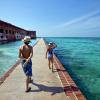Northwest Florida is a living museum of culture and history. Festivals, museums and real-life historians bring the area to life.
By James Davis
I’m drifting in a small, flat boat in the shallows of Apalachicola Bay, looking for flounder to gig (i.e., spear through the head). This is only after I get far too close to George Watkins’s Wewahitchka tupelo honey bee hives for any sense of comfort. Tupelo honey fresh off the comb, a popular product in these Gulf Coast parts, is very tasty indeed.
This could be just a day in the life in this area of Northwest Florida. You could perceive the culture here to be more interior southern living than tidal Florida.
Fortunately for my throwing arm, and thankfully for my karma, it’s too breezy to find flounder. The wind is stirring up the bottom and the fish have become effectively camouflaged. So my guide, poling us along, fills in the time by telling me stories about his life.
“I hunt wild boar with my dogs over there,” he points to an island, “and there’s also some deer there that are so big they look more like small horses. Yes, ma’am, they surely do.”
He also confides that he was gigging (spear-fishing, not dancing) the night his wife went into labor with “her” first child, and that he himself was the inaugural baby born in the area hospital.
It is these types of stories and people that bring the area to life. Where there is a lack of glitz and glamour, there is an abundance of personality. Here perhaps more than elsewhere in Florida, you’re likely to find folks whose families have been in the region for generations. Think of it as a living museum.
The next morning, refreshed from a night in the historic Coombs House Inn, a charming bed & breakfast close to downtown Apalachicola, I browse in The Grady Market, a group of art galleries, artisan craft boutiques and antique stores huddled on Apalachicola’s historic waterfront.
Then I hit Scenic Highway 30-A for a leisurely drive through South Walton, heading ultimately for the WaterColor community, just one of the “unique communities” where the architectural styles and color palettes have been perfectly orchestrated by award-winning designers. WaterColor is Nuevo Cracker-style, a look known for such pristine Southern charm that Seaside, a nearby community of the same style, was chosen as the main setting for the movie "The Truman Show."
Perhaps because of this pedigree, WaterColor was also a tour stop for the Telluride MountainFilm on Tour, a festival of independent filmmakers who highlight community, adventure, culture and environmental preservation in their works.
Indeed, many such celebrations take place in South Walton, including the Flutterby Arts Festival, which vanguards the Monarch migration through the area.
The choice of subject matter seems apropos for the whole of this Northwestern Florida region, which is being kept “green” and deliberately sedate in accordance to its folkloric roots.
What visitors get out of the dichotomy that ranges from rural Apalachicola, built in 1831 as a cotton-shipping port, to sophisticated WaterColor, is a lure for everyone from best-selling artists to millionaire retirees, in a mixture of Forgotten Coast history, cultural energy and natural tranquility.
You can spend your days wandering restored properties and antiquing as leisurely as you like, but there’s also a tremendous variety of activities to be enjoyed, from taking in a live musical performance or event at the restored 1912 Dixie Theatre to attending the First Friday Art Walks in Ruskin Park at Seaside.
In addition, you can embrace the culinary arts in a completely organic sense by fishing and crabbing in the estuaries, then supping in fine style at Fish out of Water in The WaterColor Inn and Resort, a David Rockwell-designed, 60-room boutique hotel.
It’s all overlaid by some of the most incredible natural beauty that Florida has left. So wherever you decide to go — St. George Island for solitude, shorelines and shrimp or Seaside for the Seaside Rep Theatre's fall play—rest assured that every experience on or near The Forgotten Coast will be remembered . . . flounder gigging, perhaps, aside.























